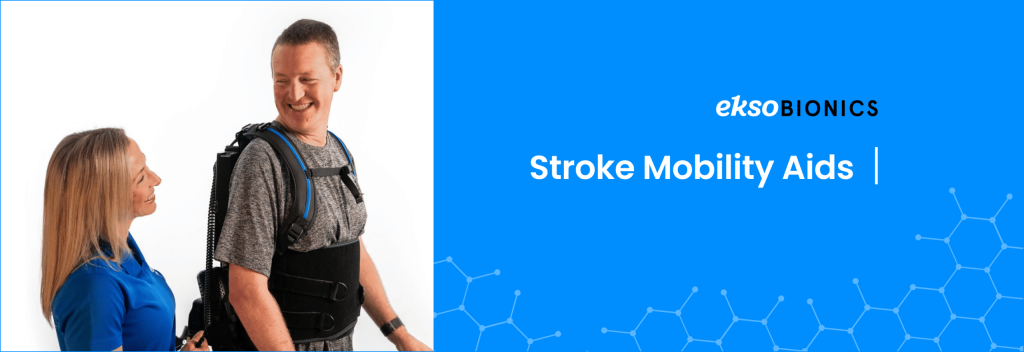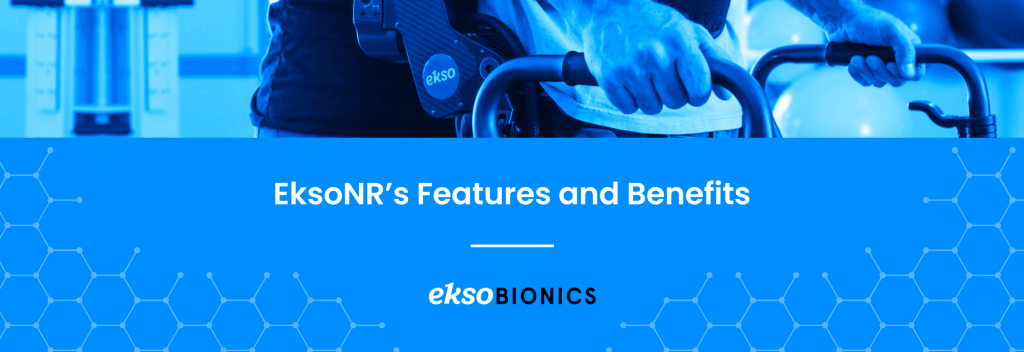Stroke is the leading cause of disability.[1] In a report published by the CDC, about 795,000 people in the U.S have a stroke every year, with 610,000 being first strokes and nearly 185,000 being repeat strokes. [2] This results in reduced mobility, balance, and coordination. Stroke also limits social interaction and activities of daily living (ADLs) due to impaired mobility and balance.
If you are recovering from a stroke, you’ll generally be subjected to a few weeks of inpatient rehabilitation which targets the recovery of independent ambulation. After rehabilitation at the hospital, you’ll be discharged and given a cane, brace, walker or wheelchair, depending on the progress of your recovery.
Stroke Mobility Aids

Mobility devices are apparatuses that support the user’s mobility and help them move around. These include walkers, canes, wheelchairs, and even orthotics. They may help increase your independence, reduce residual disability, and slow the decline of certain functions.
- Rolling Walker
Rolling walkers help support mobility by providing balance and supporting the leg muscles. To move forward, apply force with your arms and make a step in the direction you wish to go. There are two types of walkers: 2-wheel walkers and 4-wheel walkers. Some walkers have seats which can allow you to take a break anywhere.
Walkers are a great mobility device for people who are not entirely immobile. However, when using a walker, the body uses the hips for balance instead of the ankles. This inadvertently leads to reduced ankle sway, which results in decreased ankle strength and flexibility, prompting a decline in mobility.
- Cane or Quad Cane
Canes are normally used to steady the body while in motion, contributing to improved balance and lower risk of falling. The quad cane is the best option for people who need a little support —using a cane when walking increases your base of support, providing you increased balance. When in motion, it causes your center of gravity to shift in the cane’s direction. This reduces postural sway which aids in mobility and balance.
- Wheelchair
Wheelchairs are great mobility devices if you are completely immobilized or get fatigued easily. There are different chair designs and options available in the market, but the most important thing is to ensure that a wheelchair is specifically designed for your needs and environment. The comfort of the person using the wheelchair is vital because poor fit can lead to discomfort. It can also cause back injuries, reduced mobility, skin breakdown, and affect how well they can propel the chair. Therefore, always consult with a healthcare professional in order to get the type of wheelchair that addresses your specific needs.
- Orthotics
An orthosis is an artificial external device that is created to support a joint or body part. It is normally used to offer the wearer stability, protection, and support. An orthosis varies depending on the area of the body they are being worn and can be fabricated or custom-made. Ankle-foot orthoses are commonly prescribed to individuals recovering from a stroke. They are used to improve gait by providing support to the knee and ankle, helping to keep your toes from dragging on the ground when swinging that leg, and keeping you steady over that foot when you are putting weight on it. The main function is to help you become more independent with your activities of daily living (ADLs) and mobility. Just like a wheelchair, selecting the right device is essential to get the best support and results.
There are also orthoses that can be used if your muscles have become tight. Two types may help assist you in stretching and recovering the lost range of motion:
- Static orthosis: It cannot move and is normally used to apply force to a joint and hold it in a position to increase the passive range of motion.
- Dynamic orthosis: It is mobile and is worn to support the proper movement of a joint.
When prescribed, orthoses are used to maintain range of motion, manage pain, prevent contractures, protect tissues, support weaker muscles, prevent unwanted movement, and increase function.
Exoskeletons for Stroke Recovery

Walkers, canes, wheelchairs, and orthotics are great devices for mobility. However, not all individuals recovering from a stroke will be able to practice walking or use them in their daily life, especially if they need more assistance from their therapist. This is where the exoskeleton comes in. An exoskeleton is a powered robotic gait training device that is used to support the movement of lower limbs through repetitive overground walking practice.
One such exoskeleton that the FDA approves for the rehabilitation of individuals recovering from a stroke, brain injury, spinal cord injury, and MS is EksoNR. It re-trains the user’s brain and the muscles on how to walk again by ensuring the most natural gait pattern is achieved during rehabilitation. EksoNR is currently available for use in more than 400 rehabilitation centers around the world.
EksoNR’s Features and Benefits

EksoNR contains special features designed to help you regain mobility quickly and effectively. They include:
- Pre-ambulatory tools – This is a set of programs designed to help you make a step, squat, balance, and shift your weight before walking. It helps form the foundation of necessary movements.
- Adaptive gait training – EksoNR contains sensors and software that monitor and correct leg movements to reduce compensatory gait patterns.
- Smartassist software – Your physical therapist can customize the amount of support EksoNR offers in the swing and stance phases of walking, depending on your impairment level.
- Clinician control – With EksoNR, it is possible to set training goals and change the assistance levels for each leg based on the goals you have set and the feedback after the session.
- Posture support – To help maximize rehabilitation sessions, EksoNR provides support by ensuring proper postural alignment as you move.
- Data capture – Your physical therapist can access all session data and analytics on the cloud-based dashboard that saves progress and data in real-time.
Ekso Bionics has had massive success in mobility rehabilitation. According to a health professional, Dr. Jennifer Cohen, MD, “Ekso helps us get patients up, out of bed, and ambulatory as soon as possible.” Duncan Monger, PT, DPT, CBIS, also says, “We were able to see an immediate impact on the patient’s ability to perform bed mobility, transfers, and independence with all functional activities after one session with the device. This device has greatly improved our patient’s outcomes while decreasing physical assistance required by staff members.”
Benefits of Exoskeletons

The impact of exoskeletons on stroke recovery is undisputed. They can help in gait training, ambulation, and improve motivation, among other related benefits.
- Ambulation
If you are recovering from a stroke, you may experience gait deficits like reduced mobility, speed, and asymmetrical walking patterns, which affect your ability to ambulate. Robotic exoskeletons help with correcting gait deficits which help with ambulation. They are used for gait training, guiding weight shifts, and improving step patterns and cadence.
In a study investigating the effects of robotic exoskeletons on functional ambulation in adults with stroke, it was reported that exoskeletons help increase functional ambulation. Additionally, it’s an effective way of providing high-dose therapy without increasing the duration of training. [3]
- Gait Rehabilitation
Traditionally, gait training involves exercising on a treadmill with the assistance of physical therapists. On the other hand, exoskeletons help you improve your gait by practicing your walking movements repetitively and correctly with anatomically aligned motors. This also aids in the strengthening and recovery of leg muscles and improves coordination. Exoskeletons also track progress and document improvement, which can be used to analyze your rehabilitation progress. According to a recent study, combining exoskeletons and conventional gait training therapy may lead to better results and a more efficient gait. [4]
- Improved Motivation
Rehabilitation sessions with exoskeletons include walking time which is a huge morale and motivation booster, especially if you cannot move. Moving and holding conversations at eye level in an exoskeleton is empowering and may help improve your enthusiasm. This can lead to more steps per session and increased functional independence. [5]
- Reduces Burden on Physical Therapists
Rehabilitation can sometimes be taxing and very exhausting for therapists. Fangshi Zhu, Senior Biomedical Research Scientist at the University of Texas Health, says, “Traditional therapy usually involves two or three physical therapists manually guiding a patient’s impaired limb to follow and reinforce the desired trajectories, which can be very labor-intensive and even unsafe.” [6] This limits results as physical therapists cannot provide enough high-dose, task-specific repetitive gait training during the acute stages of recovery.
With exoskeletons, you only need one physical therapist to guide you through an exercise. This frees up physical therapists to attend to more people. Additionally, exoskeletons can deliver so many gait repetitions during the acute recovery phase, which helps in positive rehabilitation outcomes.
Conclusion

There are many mobility devices available for people who are recovering from a stroke. However, they are not the foolproof solution in mobility rehabilitation. For example, wheelchairs cannot help you practice your walking skills. In fact, sitting all day may negatively impact mobility skills. Exoskeletons are purposely built for rehabilitation and can assist you in developing your mobility, strength, and balance.
Ekso Bionics is a leading exoskeleton manufacturer which has been making the best-in-class medical exoskeletons for over a decade. Our mission is to create mobility solutions that help individuals recovering from a stroke, brain injury, spinal cord injury, and MS walk again. To learn more about the exoskeletons we create to benefit a variety of conditions, contact us at 510-984-1761 or request a free demo online.
Appendix:
- The global burden of stroke: persistent and disabling https://pubmed.ncbi.nlm.nih.gov/30871943/
- Stroke Facts | cdc.gov https://www.cdc.gov/stroke/facts.htm
- (PDF) Effect of robotic exoskeleton gait training during acute stroke on functional ambulation https://www.researchgate.net/publication/350507385_Effect_of_robotic_exoskeleton_gait_training_during_acute_stroke_on_functional_ambulation
- Robotic Exoskeleton Gait Training in Stroke: An Electromyography-Based Evaluation https://www.frontiersin.org/articles/10.3389/fnbot.2021.733738/full
- Robotic Exoskeletons May Provide Health Benefits for People with Spinal Cord Injuries | National Rehabilitation Information Center https://naric.com/?q=en/content/robotic-exoskeletons-may-provide-health-benefits-people-spinal-cord-injuries
- How can powered exoskeletons restore walking ability after stroke? – Physics World https://physicsworld.com/a/how-can-powered-exoskeletons-restore-walking-ability-after-stroke/